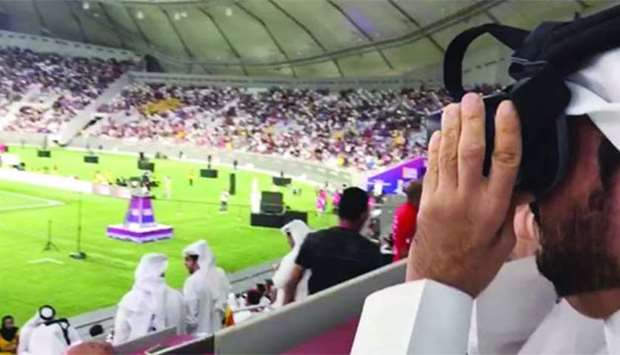Ooredoo successfully showcased three futuristic applications designed to enhance the overall experience for selected spectators at Khalifa International Stadium during the recently held Amir Cup final, the company said on Monday.
This came as further demonstration of the potential of Ooredoo’s 5G technology, according to a press statement.
The applications, which in future would solely run on the Ooredoo 5G network, included an engagement platform to provide robust real-time video streaming, an augmented reality venue engagement solution and immersive VR based on high-performance Multi-access Edge Computing (MEC solutions), the statement noted.
MEC allows applications to be hosted closer to the edge of the network, therefore closer to subscribers, to efficiently use network resources and open up new opportunities for the delivery of compelling, tailored services in high-traffic locations. With this technology, video feeds can be efficiently broadcast to multiple subscribers’ devices simultaneously with millisecond latency, Ooredoo has explained.
Speaking about the demonstration, Waleed al-Sayed, CEO of Ooredoo Qatar, said: “Last week, Ooredoo became the first company in the world to launch 5G technology and we promised to further demonstrate the potential that this will bring for Qatar in the future. With Khalifa International Stadium set to host several 2022 World Cup matches, we believed the final of the Amir Cup was the perfect opportunity to showcase this state-of-the-art technology to the world, which in the very near future will be run seamlessly on the Ooredoo 5G network.”
At the event, Edge Video Orchestration allowed visitors to access live video streams of the game from different angles. As part of the solution, four 360-degree cameras were installed at various locations on the football pitch to capture action from multiple viewing angles. These cameras transmitted live video streaming of the game to the consumer devices enhancing the viewing experience.
The Immersive Virtual Reality solution enabled remote viewers to attend the match as if they were present in the stadium. In the future of digital venues, this solution will enable sports venues to serve their fans globally, by extending live views and data to fans, allowing them to join in the events virtually from remote locations around the world.
Finally, the Augmented Reality-based navigation solution helped visitors navigate and access different locations inside the stadium by combining a live view of the stadium with additional computer-generated elements rendered into the mobile device’s display. The application could be used to navigate to spectator seats, parking spaces, or food and merchandise sections.
“Ooredoo’s 5G network is an important technological breakthrough for the telecommunications industry worldwide and we want to lead the way in rollout and ‘use cases’ of this state-of-the-art technology. Stay tuned for more 5G news in the near future,” added al-Sayed.
Ooredoo’s 5G Supernet deployment is currently underway and will begin by covering an area from The Pearl-Qatar to Hamad International Airport, with Lagoona, Katara – the Cultural Village, West Bay, the Corniche and Souq Waqif.
Access to the Ooredoo 5G Supernet will require a 5G compatible device, which is set to be available from 2019 worldwide.
The applications, which in future would solely run on the Ooredoo 5G network, included an engagement platform to provide robust real-time video streaming, an augmented reality venue engagement solution and immersive VR based on high-performance Multi-access Edge Computing (MEC solutions), the statement noted.
MEC allows applications to be hosted closer to the edge of the network, therefore closer to subscribers, to efficiently use network resources and open up new opportunities for the delivery of compelling, tailored services in high-traffic locations. With this technology, video feeds can be efficiently broadcast to multiple subscribers’ devices simultaneously with millisecond latency, Ooredoo has explained.
Speaking about the demonstration, Waleed al-Sayed, CEO of Ooredoo Qatar, said: “Last week, Ooredoo became the first company in the world to launch 5G technology and we promised to further demonstrate the potential that this will bring for Qatar in the future. With Khalifa International Stadium set to host several 2022 World Cup matches, we believed the final of the Amir Cup was the perfect opportunity to showcase this state-of-the-art technology to the world, which in the very near future will be run seamlessly on the Ooredoo 5G network.”
At the event, Edge Video Orchestration allowed visitors to access live video streams of the game from different angles. As part of the solution, four 360-degree cameras were installed at various locations on the football pitch to capture action from multiple viewing angles. These cameras transmitted live video streaming of the game to the consumer devices enhancing the viewing experience.
The Immersive Virtual Reality solution enabled remote viewers to attend the match as if they were present in the stadium. In the future of digital venues, this solution will enable sports venues to serve their fans globally, by extending live views and data to fans, allowing them to join in the events virtually from remote locations around the world.
Finally, the Augmented Reality-based navigation solution helped visitors navigate and access different locations inside the stadium by combining a live view of the stadium with additional computer-generated elements rendered into the mobile device’s display. The application could be used to navigate to spectator seats, parking spaces, or food and merchandise sections.
“Ooredoo’s 5G network is an important technological breakthrough for the telecommunications industry worldwide and we want to lead the way in rollout and ‘use cases’ of this state-of-the-art technology. Stay tuned for more 5G news in the near future,” added al-Sayed.
Ooredoo’s 5G Supernet deployment is currently underway and will begin by covering an area from The Pearl-Qatar to Hamad International Airport, with Lagoona, Katara – the Cultural Village, West Bay, the Corniche and Souq Waqif.
Access to the Ooredoo 5G Supernet will require a 5G compatible device, which is set to be available from 2019 worldwide.



